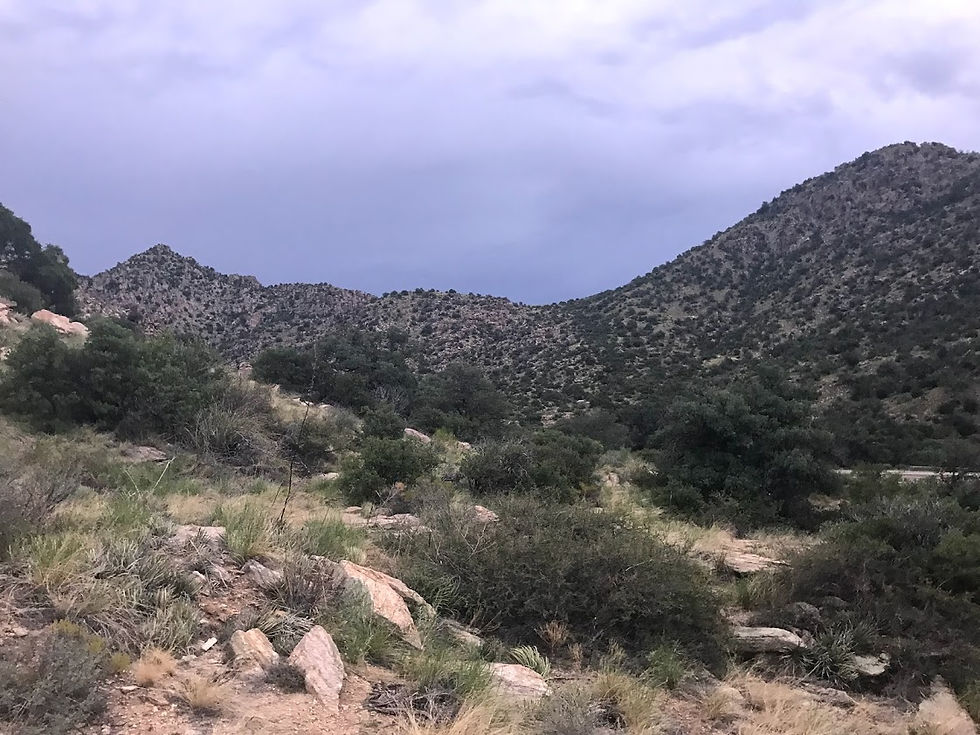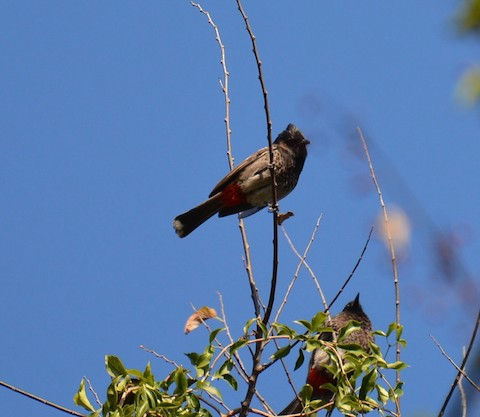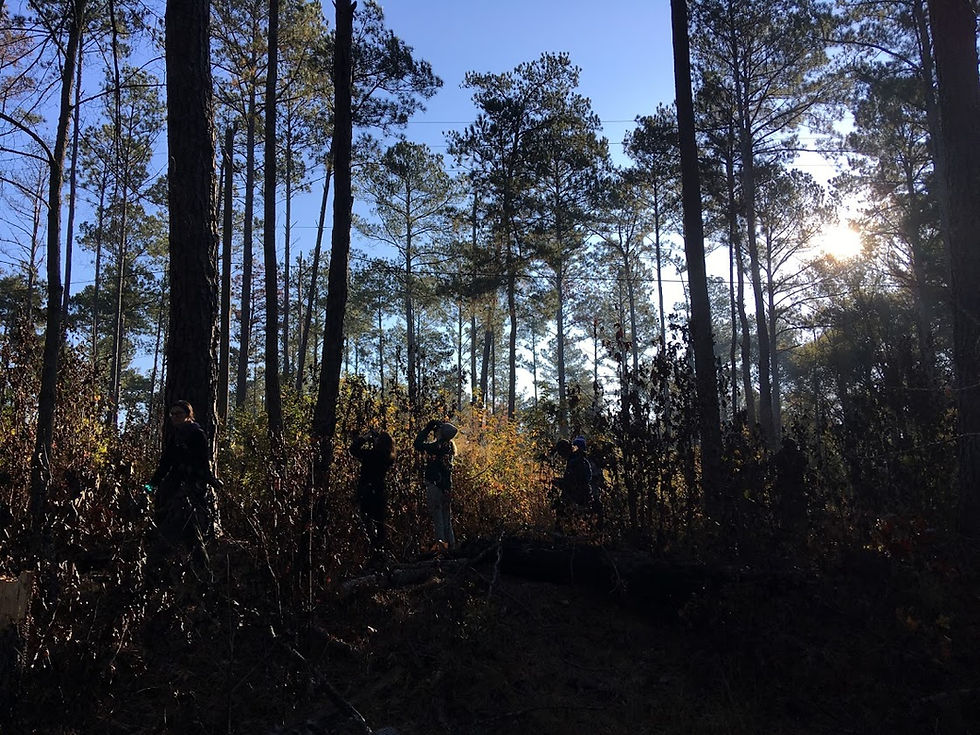Going Out West
- pnkleinhenz
- Dec 4, 2019
- 8 min read
One of the big trips Heather and I planned for our Big Year was one to the birder's mecca of Southeastern Arizona. We only could afford 3 1/2 days there but, as always, we intended to make the most of that time. We flew out there on a Tuesday, each on separate flights. When we arrived around the same time in Phoenix, my best friend, Colin, and his two lady friends were there to pick us up. With their cute little puppy, Momo, in tow, we were off.

Although we were all ready to go to the Tucson area, the big city of Phoenix did contain at least one species found nowhere else. The non-native Rosy-faced Lovebird occupies certain areas near downtown Phoenix, and we figured that we could find this with minimal effort. We visited Encanto Park, near the heart of Phoenix, to try our luck.
As we were putting our boots on outside the car, I looked up to follow a strange call I hadn't heard before. When I did, I immediately realized who was making it. A large flock of lovebirds had just flown into the top of a palm, allowing all of us to immediately check this species off of our life list. While not native, these birds seemed to fit right in and, I must admit, were pretty little birds.
We walked around this odd park for maybe 20 minutes. It wasn't big, but its ponds and landscaped areas seemed to attract a lot of birds. In that short span of time, we added our first Gila Woodpeckers and Great-tailed Grackles while also getting to know each other. But we were ready to get down south.
I figured that we needed to try for desert birds before shifting our focus to the unique birds of the sky islands, isolated mountains found in and around the Tucson region. Our destination would be Catalina State Park, located just east of the city in the foothills of Mt. Lemmon. The temperature was...sweltering...when we arrived. We did not expect to see a whole lot but were going to devote an hour or so to try.

Surprisingly, we did quite well despite wanting to die from the heat. A White-winged Dove flushing from a tree was one of our first new birds. You may remember that we struck out with them repeatedly in Central Florida, so it was about time we saw one. In addition, we observed a stunning male Western Tanager hanging out in the top of a nearby mesquite tree. I should mention that the saguaro cactus/mesquite forest was quite unusual, but seemed to offer just enough resources to attract many birds I haven't seen in true, open desert in the past.

To prove this point, we got into a denser growth of mesquite that was a bit more shaded. Black-tailed Gnatcatchers buzzed like bees around the tree tops. Our first Ash-throated Flycatcher, one of my favorite flycatchers, sat near the top of a mesquite while it took a break from catching insects. A few Gila Woodpeckers graced us with their presence as well, taking the total number of Gila's I'd seen in my life from 1 to 5 in a matter of minutes.
We walked into a more open, shrubby section of the park. One of the first birds we saw here was a Blue Grosbeak of all things! Somehow, we had missed this bird in Florida and Georgia together, despite Heather and I both observing the species separately innumerable times. The fact that our first one was in Arizona cracked us up but, hey, at least we had it! Another interesting bird we observed in this habitat was a sparrow we didn't recognize at first. I pulled out my field guide and looked for a sparrow with a distinct rufous crown. I laughed when I realized that we were looking at the aptly-named Rufous-crowned Sparrow.
A cool sight for Heather, especially, was a Greater Roadrunner that raced out of a clump of shrubs, stood in the middle of a wash to look at us, and then raced onward. They are such odd birds. We hiked up this wash further, since we noticed some cliffs and interesting habitat up ahead. It was here that we first heard the gorgeous, descending call of Canyon Wrens. This unforgettable call stayed with us on most hikes for the rest of the trip.
We were getting so hot, and it was time to turn around. En route to the car, a strange bird flew up into a mesquite. I got it in the binoculars and recognized it as some kind of vireo. We all got eyes on it and, while I read out field marks from my guide. We were thrilled to discover that we were looking at our first Warbling Vireo for the year. This strange bird is one I didn't think we'd be able to see or identify but, there it was! In all, we racked up 8 new species for our year list at this one spot. Woohoo!
It was time to head to one of the most well-known birding destinations in Arizona: Mt. Lemmon. This huge sky island looms above Tucson and, due to its elevation gradient, houses a huge number of bird species. Our plan of attack was to start at the tippy-top and work our way down. We wound our way up the mountain, reaching the uppermost parking lot after what seemed like forever. The habitat consisted exclusively of conifers and the open forest was occasionally punctuated by open, grassy meadows. Time to search.

Our first stop was productive. Yellow-eyed juncos were the most common bird! These high-elevation versions of the more familiar Dark-eyed Junco seemed to be everywhere. Above us, high in the firs, we could hear a high-pitched call. Using the Merlin app, we quickly identified this call as that of a Hermit Warbler! We tried desperately to see the bird, but failed (at first). We heard four more calling as we traversed the area and, eventually, lucked out and were able to see the brilliant yellow face of this beautiful bird.
A strange, but somewhat familiar, call met us next. We listened hard as it called, playing various calls through our app in an effort to find a match. Eventually, we did. It was our first Mountain Chickadee, and our only one on the entire trip! Normally, these have been easier to find for me but they seemed to be scarce everywhere. Sadly, we never got a look at this one but were rewarded with looks at a bird that Heather wanted to see very, very badly. We had heard some high-pitched squeeks and Heather, a bird call expert, recognized them despite never having heard them before in the wild. A glance through binoculars confirmed what she thought....Pygmy Nuthatches! Heather studies their closest relative, the Brown-headed Nuthatch and this was the last species in the U.S. that she had left to see. She was VERY excited to see them!
We reached an open meadow and Colin spotted a hummingbird buzzing around. That thing was tough to lay eyes on but it finally hovered in one place long enough to see it clearly. This was not only our first hummingbird of the trip, but was one we didn't necessarily expect to see on this outing. It was a Broad-tailed Hummingbird, and it rewarded our patience with wonderful looks. Broad-taileds can be tough to separate from other species and we all appreciated it giving us the time to feel certain about our identification.
I've always found flycatchers interesting, and I was elated to see one perched on a fence at the edge of the meadow. It flew from the fence onto a low branch of a nearby pine, then went back to the fence. I didn't recognize it at first, which eliminated several species. It certainly wasn't one of the many Empidonax flycatchers that look almost identical. This one was different. It's eye-ring formed a distinctive "teardrop" behind its eye and a bright yellow belly. It looked similar to a Pacific-slope Flycatcher, but the range and habitat ruled that out. We were looking at all of our first Cordilleran Flycatcher! I was pumped about this bird. Not only was it a lifer, but it was one we certainly wouldn't be able to bank on seeing anywhere. What a productive stop!
Our next stop would be the first of many "feeder stops" during the trip. This one consisted of a large conglomeration of feeders in a type of condo/resort area on the mountain called Summerhaven. I have to say, sitting there in the perfect weather looking at birds while the valley below was scorching did lend credence to that name. The feeders were alive with activity. Lesser Goldfinches, new for us, were everywhere. Several Rufous Hummingbirds and one Broad-tailed Hummingbird visited the hummingbird feeders, and three Black-headed Grosbeaks seemed to be obsessed with the seed feeders. The grosbeaks were our first for the year, but are also such neat-looking birds. Despite needing to keep moving, we stayed for an extra ten or fifteen minutes just watching all of the birds interact on the feeders.

Light was slowly beginning to disappear and, amazingly, we only had time for two more short stops on the mountain. The first took us to a shaded picnic area deep in the pines called Marshall Gulch. In addition to the day ending soon, it also was beginning to rain. We pushed through the rain regardless and, despite seeing only one new bird, the hike was delightful. What was the new bird, you ask? Believe it or not, it was our first Acorn Woodpecker of the year! Though Colin, his girlfriends, and I had seen Acorn Woodpeckers many times, this was a first for Heather. Seeing species fresh through Heather's eyes makes me realize just how cool some of the birds I take for granted actually are.

The remainder of the hike took us to high, rocky overlooks but did not produce many birds. A recent report of a Common Black Hawk brought us to our final daylight stop. This was Rose Canyon and Lake, a small fishing lake surrounded by a trail. We walked up to the lake and scanned for the rare hawk that was supposedly present earlier in the day. Nothing, of course. We were bummed, but it was around the time of that perceived failure that success found us. Birds seemed to come in from nowhere. I looked up to see what the birds were that flew in overhead. They were difficult to find but, eventually, I got a perfect look. I couldn't believe it...these were our first Olive Warblers and were lifers for everyone! I've read that Olive Warblers aren't always easy to find and, yet, here around us were two separate individuals! I LOVED these birds and must say that this particular experience was one of my favorites of the Arizona trip!
But the good finds weren't over. We walked towards a lookout deck on the lake but stopped dead in our tracks on the way. A flash of red had caught Heather's eye. There, on a branch right in front of us was a Painted Redstart and a Red-faced Warbler...together! We had a brief look at a Red-faced Warbler right when we got out of the car at the parking lot, but this view was beyond great. Both birds were no more than 10 feet from us, and were sitting close enough together to be able to see both in the same binocular scan. It was something that can't happen often, and we were all ecstatic to get such excellent looks at both species.
Darkness was now impending, so we made our way down. We had time for one last stop, despite it being after sunset. Here, we walked around the rocky Molino Basin, looking mostly for snakes. While walking up a nice wash, Colin, Heather, and I made an amazing find. We were shining headlamps into crevices and over rocks, when Colin yelled, "Snake!" I looked over to see an absolutely stunning example of a Black-tailed Rattlesnake coiled up nicely on a rock. We took some photos from afar and admired its beauty, careful to not disturb it. We walked up further and, when we came back, the snake was right at the same rock. Clearly, this was a good site from which to ambush prey.

Two new birds resulted from this stop. Both were heard only. A bird flew away after we flushed it, right after sunset when we were parking our cars. We didn't get a great look, but heard it call once it landed. Some Merlin App sleuthing led us to definitively conclude that it was our first Cassin's Kingbird! Later, while searching for snakes, we heard the distinctive call of a Common Poorwill. Not bad for a random stop!
We were VERY tired, and I could barely think by the time we pitched our tents at the foot of Madera Canyon and rested up for what promised to be another, even more intense, day of birding.








Comments